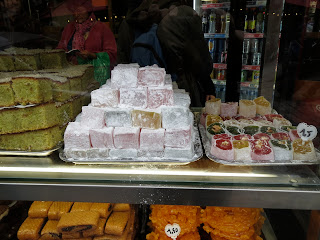This week, the Urchins of Paris!
Wait, what? Do you mean those delightful scamps that run around making mischief in the streets ??
Not street urchins-but oursins! Or Sea urchins! (tests-the dried internal skeletons shown here)
This week: some of the rich and diverse holdings of the Museum national d'Historie naturelle!
Sea Urchins (oursins!) or members of the Echinoidea are of course-the echinoderms that look like a big spiny ball (this includes sand dollars and sea biscuits!). Sea urchin specimens comprise an incredibly diverse (and important) collection in Paris with holdings from all over the world-especially from the tropical Indo and South Pacific! Undoubtedly many new species await description!
So for example here we have the very incredible looking Chondrocidaris gigantea
Others from the tropics are distinctive and RED but remain sadly, unidentified. Is this a new species awaiting discovery??
In addition to the above "regular" urchins, here are some cleaned tests (again-the skeleton of an urchin with all the spines removed) of some "irregular urchins" (distantly related to sand dollars).
A test of Schizaster edwardsi from the Atlantic...
I believe this one was called Breynia but not sure which species.
But why limit yourself to enjoying only the outside of these skeletons when you can go INSIDE?? No-not x-rays...but old-school careful dissection...
Here's the Atlantic "sea biscut" Clypeaster rosaceus with the "top" completely removed..
showing the internal struts around the mouth...Go ahead and take a walk around inside a sea biscuit!
The long history of the museum permits me to share with you some display mounts from a bygone era...
These are the individual spines of various species mounted on one plate each. These are easily 100 years old and are possibly MUCH older... probably from the 1800s...
Here is a vintage 1894 specimen collected by the sea urchin researcher Gustave Honoré Cotteau (he died in 1894 so this is probably just a note indicating the specimen is part of his collection).
Here is a brief summary of who he was (in French) A short summary translation of his bio (some edits for clarity):
Judge, naturalist, geologist.
Gustave Cotteau made a career in the judiciary while devoting himself to paleontological studies. It was a judge in civil court Coulommiers civil court judge in Auxerre (1867), and retired in 1874.
As a scientist, he devoted himself to the research and study of living and fossil echinoids, which he had a collection of over 500 species. With numerous articles in newsletters and journals of learned societies which he belongs, he continued the publication of the collection founded by Alcide d'Orbigny in 1840, Paleontology French. He was curator of the town of Auxerre.
Secretary-General of the Institute of Provinces, responsible for publishing the reports of international conferences of Prehistoric Anthropology and Archaeology and the annual reports on the progress of geology and paleontology in France from 1858 to 1869...
You can check out some of Cotteau's work at the Biodiversity Heritage Library site HERE (for free download). But Cotteau was a prolific author and wrote MANY classic texts on fossil echinoderms.
Okay! Now time to go get some Turkish Delight! More next week!




















1 comment:
I don't remember how I ended up at your blog, I do know I love it!
I'm amazed at this animals. I remember learning about them in middle school, so to see them again it's great. Thank you, a lot, for sharing your knowledge and your work and your curiosity through the web.
There's now a mid-twenties woman in Guadalajara, México, who loves your blog!
Post a Comment